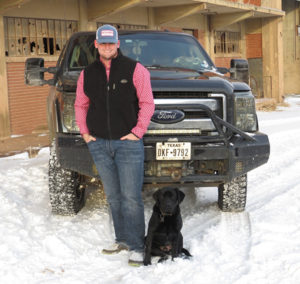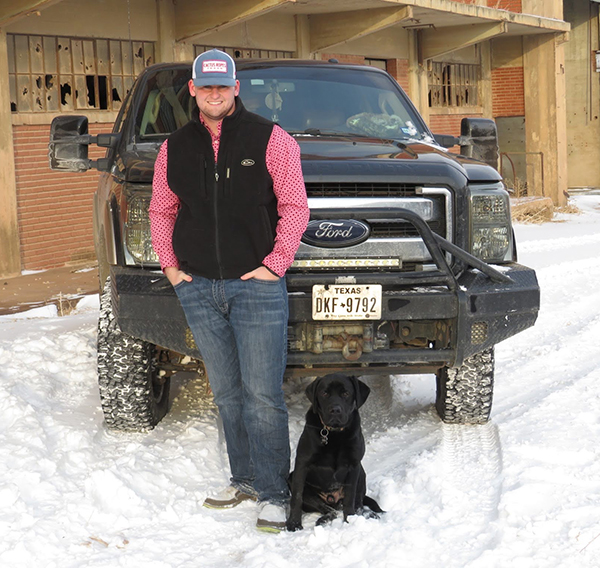By JORDAN GREEN, Editor-in-Chief

The month was July, and Sam Gentry was dog tired of living without a furry friend.
The dog days of summer were finally upon him.
“I had always wanted a little buddy,” Gentry said. “Especially now, it seemed like a good opportunity. Half the time, we weren’t in school. And obviously, sporting events have been kind of closed off, shut off right now. It was just the perfect opportunity and perfect time.”
He searched Facebook advertisements in search of the right K-9 companion. After taking a trip to a breeding facility in Jefferson, Missouri, he fell in love – puppy love, that is.
“I got ole Drake at the end of July, so kind of like dead-smack in the middle of everything,” Gentry said. “He’s a black Labrador. He’s a great companion, especially with everything going on right now.”
Gentry, a junior general studies major at Northwestern, is one of thousands of Americans who have adopted pets since the coronavirus pandemic began almost one year ago. With Americans being relegated to their homes, distanced from their coworkers, friends and family members, some have warded off feelings of loneliness by bringing pets into their houses, their lives and their hearts.
Across the region, animal shelter officials say they believe animal adoptions have increased during the pandemic.
‘IT MADE PEOPLE MORE COMMITTED’
At the Northern Oklahoma Humane Society in Ponca City, 97 miles east of Alva, animal adoption numbers in 2020 more than doubled compared to 2019 figures. In 2020, the animal shelter adopted out 530 animals, compared to 224 the year before.
Ashley Villines, the shelter’s executive director, started her job in February 2020, one month before lockdowns were imposed across the nation. Her first order of business was to revamp the shelter’s adoption process, making it easier and simpler for people to adopt pets, she said.
“We were extremely hard to adopt from before,” Villines said. “It was almost like adopting a child, a long, drawn-out process. And now, it’s just not that way.”
To adopt a pet at the facility, potential adoptees must fill out a questionnaire and speak with shelter workers about how they plan to care for their pet.
Villines said the new adoption process may have contributed to the shelter’s higher adoption numbers.
In spite of the easier adoption process, though, finding the time to pick up a pooch or a feline became more difficult. From March to June 2020, the facility was open by appointment only to allow for social distancing.
“We were nervous that that was going to cut down on our adoptions, and it really didn’t,” she said. “If anything, I think it made people more committed because they chose an animal, scheduled an appointment to come meet that animal, and they’re already kind of invested in that animal before they get here.”
When the pandemic began, Americans started working from home in record numbers, and others who were used to seeing their friends and loved ones weren’t able to visit them anymore. Villines said “at least a handful” of people came in to adopt animals for this reason.
“There have been several older people,” Villines said. “We did have an older gentleman that came in that, you know, he wasn’t getting visitors as frequently because of COVID, and adopted a cat.”
One woman told Villines she adopted a cat to keep her company while on the job.
“She was like, ‘I’m at home,’” Villines said. “‘This is my little companion while I’m on my Zoom meetings.’”
As adoption numbers rose, so did volunteer numbers. One woman who was visiting from California when the pandemic began was forced to stay in Ponca City for several months more than she expected to. She began working with some of the shelter’s harder-to-train dogs, Villines said.
But even though more of the shelter’s animals found homes in 2020, some owners had to surrender their animals to the shelter. The number of pets taken to the humane society in 2020 increased by more than 100 compared to 2019 numbers.
“There’s a lot of people who have had to surrender their pets because they lost their job or because they had to move for their jobs and they couldn’t take the pet with them,” Villines said. “I think that’s a big driving factor for people, knowing that the pets are being affected by this as well, and they’re losing their homes and what they’re used to.”
Financial constraints have hurt animal shelters as well, Villines said. Operating the shelter costs about $8,000 per day. Keeping the shelter afloat was stressful at times because donations decreased, she said. The shelter relied heavily on funds collected during one fundraiser at the beginning of the year, which brought in about $60,000.
“That’s pretty much what saved us through 2020, because we really weren’t able to do much of anything else besides that fundraiser,” she said. “I always hate asking for money, but at the same time, if we don’t have those donations, we don’t have the shelter.”
Donations did pick up toward the end of the year, she said, though she encourages people to donate if they’re able – and to adopt a pet if they can.
“There really is not a good reason not to adopt,” she said.
NATIONWIDE, ADOPTIONS DECREASE
While some animal shelters reported having slightly higher-than-normal adoption numbers in 2020, adoption numbers nationwide were lower than they were in 2019.
Data from Shelter Animals Count, a nationwide non-profit organization that tracks adoption data from thousands of animal shelters, showed that pet adoptions from January to November 2020 were down 18% compared to the same period in 2019.
The year started strong for pet adoptions, but the numbers drastically dropped. Pet adoptions in January and February 2020 were higher than in 2019. But from March to November 2020, the number of pets adopted was thousands lower than in 2019.
The widest disparity between 2019 and 2020 adoption numbers was in April. That month, 83,695 animals had “live outcomes,” meaning they were either adopted out or transferred to another shelter, compared to 146,174 in 2019.
Even though adoption numbers were lower, fewer pets were surrendered by their owners to animal shelters. From January to November 2020, the number of owners who surrendered pets decreased by 25% compared to 2019. In April 2020, shelters took in 96,213 animals, compared with 199,052 in April 2019.
SCIENTIFIC SUPPORT FOR PANDEMIC PETS
Scientific data shows that pets can help improve their owners’ mental and emotional health during times of crisis, including the pandemic.
According to the Centers for Disease Control and Prevention, one of the nation’s leading medical organizations, pets can help lower their owners’ blood pressure levels and motivate them to stay physically active.
“There are many health benefits of owning a pet,” CDC officials said in a 2019 website post. “They can increase opportunities to exercise, get outside, and socialize. Regular walking or playing with pets can decrease blood pressure, cholesterol levels, and triglyceride levels. Pets can help manage loneliness and depression by giving us companionship.”
In an April 2020 research paper, “People and Their Pets in the Times of the COVID-19 Pandemic,” professors from Case Western Reserve University, the University of Tennessee and the Adam Mickiewicz University in Poznań, Poland, found that pets may be an important form of emotional support.
“It stands to reason that pets will be a source of support during the pandemic and during the many societal and economic changes to follow,” the authors wrote. “Animals have been introduced to crisis work by way of crisis response teams. These human-animal teams provide additional resources to clergy, social workers, and other health care professionals reaching out to people affected by crisis.”
They also wrote that pets and people alike can benefit from spending time together.
“For the majority of animals, increased presence of people at homes is a major, positive environmental shift, particularly for those (especially dogs) who will normally stay in the house alone, while their carers go to work,” they wrote.

‘PUT SOME THOUGHT INTO IT’
In Amarillo, Texas, some people who are working from home have picked up pets to be their companions.
And some people have adopted additional pets after going back to work at their offices.
Lynn May, a volunteer with the Amarillo Society for the Prevention of Cruelty to Animals, said people have long thought of pets as sources of comfort and reassurance. The pandemic highlighted their importance, and when people started returning to work, they still wanted to care for their pets, she said.
“One lady was going back to work more now, so she wanted to have a friend for her cat because she had been home so much because of COVID,” May said. “She wanted her cat to now have a friend as she eases back into work. I thought that was lovely for her to do.”
May said the Amarillo SPCA, a non-profit that isn’t affiliated with the national SPCA, adopted out 260 pets in 2020.
The facility relies on donations from community members to operate the shelter. Like other shelters, the organization had to cancel some of its 2020 fundraisers. May said she hopes the organization can host some of those fundraisers again in the coming months.
She said she hopes that, as the pandemic continues, people will remember that caring for pets is a permanent task, not a temporary one.
“The big thing is to remember that they are a forever pet,” she said. “That is so important us, to hopefully find them their permanent, forever home. … So, really put some thought into everything that goes into caring for an animal and making sure that you’ve found the right one.”
A FOREVER FRIEND
Back in Alva, Gentry said he’s having fun with Drake. Drake sits in Gentry’s lap while watching TV, and Gentry is training him to hunt waterfowl. He recently took Drake out for a photoshoot.
“He’s a big goofball,” Gentry said. “He’s always full of energy. He loves to relax and chill, but he hasn’t grown into his body. He’s still learning all that.”
Like other new pet owners, Gentry has realized that raising a dog takes time. But he’s still happy that he brought a dog into his life, he said.
With Drake, Gentry’s got something to bark about.
“The first months are probably going to be the hardest,” Gentry said. “Just like having a kid, they cry, they tear things up, and they go to the bathroom everywhere. But once those couple of months get by and you train them – and you do it right – it’s a great opportunity. Everybody should have a dog, you know?”


